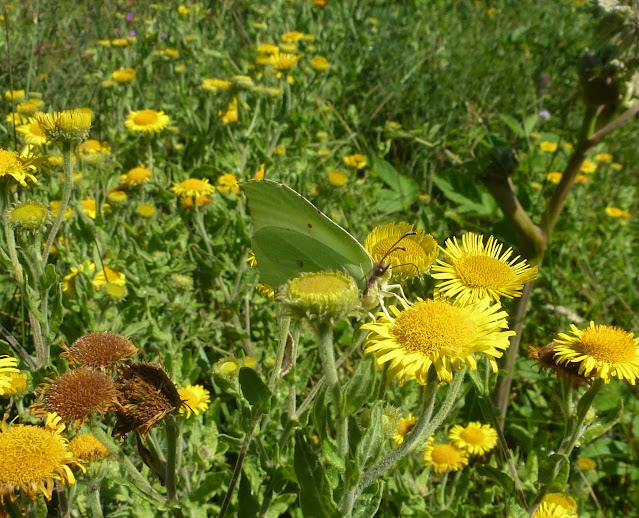The fine, hot weather was true to the forecast – about time after a mixed few weeks – as eight of us gathered to visit NWT’s Thompson Common nature reserve centre, ready for our 10 o’clock start. Though some distance from water, our first dragonflies were in the car park: a flying emperor, a ‘hanging’ female migrant hawker and a pair of common darters in tandem.
 |
| Common darters 'in tandem' (digiscoped). |
We took the winding path through open woodland, where a speckled wood was flying around, and were soon where the common is a mix of long grass and wild flowers, along with accessible pingos. On the first of these was a common emerald damselfly, with lots of powder-blue pruinescence. Ruddy darters were everywhere: not only were several pairs flying in tandem, we could also see the female flicking her tail end, shooting eggs into the grass around the wetland edge. At one point, Ann’s arm was in the way of this process and two eggs stuck to her wrist. Notable flowers in the water included lesser spearwort and hemlock water dropwort.
Two of the many ruddy darters today (Helen Crowder).
Spotted flycatchers, probably the best of today’s birds, moved around the edge of the willow scrub and hawthorn hedge on the other side of the pond. Through the telescope it was evident that there were young birds here, pale and distinctly spotty. A little later we found what seemed to be second family party of spotted flycatchers, at least four of them, a treat for what is now such a scarce bird in much of the UK. We heard Cetti’s warbler and found a great spotted woodpecker in one of the dead ashes. Other birds today included calling water rail, marsh tit, coal tit and bullfinches, though none of these showed well. Happily, as well as hearing the strident whistles of nuthatches, we also saw them.
Gall on creeping thistle, caused by thistle gall fly Urophora cardui.
We moved to the pingo on the other side of the main
path, and here we found scarce emerald damselflies (robust spreadwings). A brown
hawker was flying around. We talked about the gipsywort growing in a tussock
sedge.
Scarce emerald aka robust spreadwing (Helen Crowder).
Then a cry from Ann alerted us to a great find: a female wasp spider. These are spreading into Norfolk, though are still scarce: but this wasn’t a first for Thompson Common as this blog by Barry Madden from 2020 shows.
Naturally the sunshine brought out butterflies, including peacocks on hemp agrimony, gatekeepers, green-veined white, holly blues and a probable brown argus. Brimstones, which at first were flying around, then settled on fleabane flowers, four or five in one area.
On the furthest area we reached, we paused by patches
of red bartsia growing by the path’s edge. The search was on for red bartsia
bee, a very scarce - or perhaps overlooked – species that seems to be moving
north. It didn’t take long and there were at least two of these grey-backed,
three-striped bees. As is characteristic, they proved very difficult to photograph.Spot the brimstone among the common fleabane.
It was time to re-trace steps to the car park to eat picnics. Helen noticed a willow emerald damselfly flying into a perched position, where it stayed for us to see. Just before we were leaving, a male banded demoiselle landed near Tricia’s car.
Chris Durdin










No comments:
Post a Comment